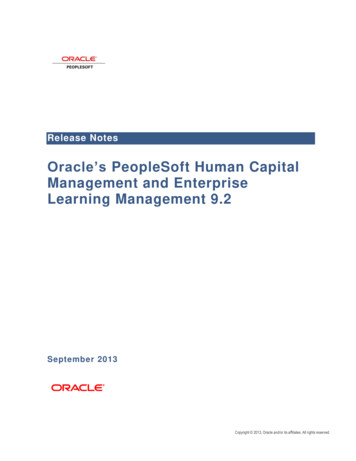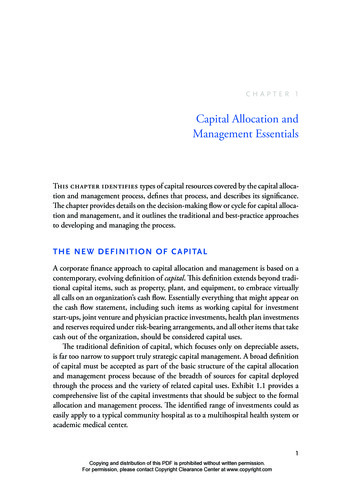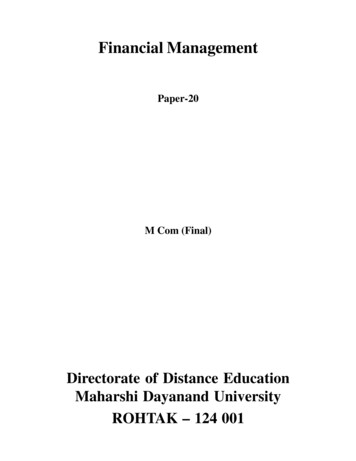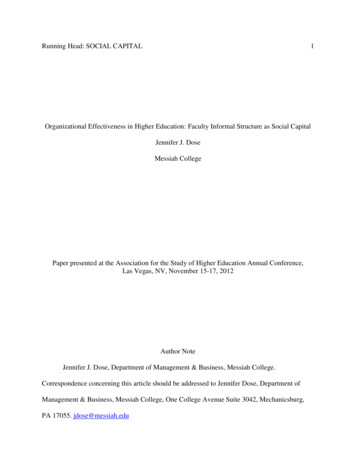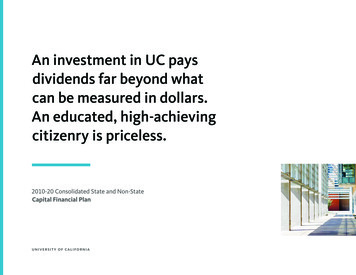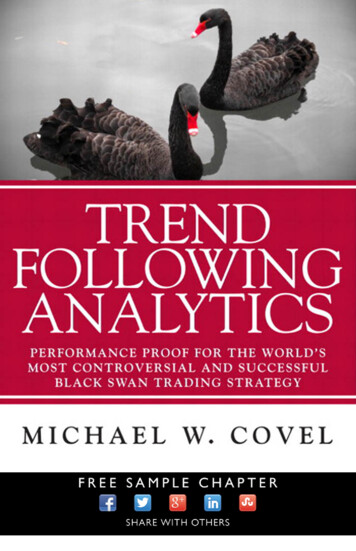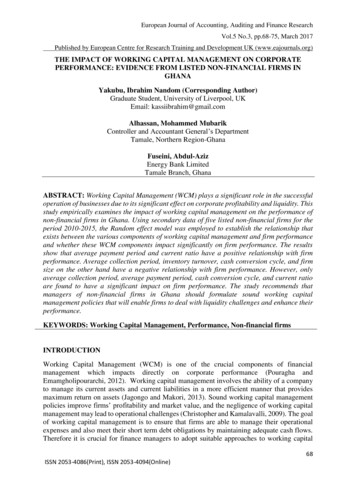
Transcription
Business and Human Capital ChallengesToday and in the FutureA Research Report by the Society for Human Resource Management
Table of ContentsIntroduction 1Executive Summary 4Business and Human Capital Challenges 9Human Capital Challenges 10Challenges Involving the HR Function 11Financial Challenges 14Perspectives: Talent Management and Engagement 17Sustaining Employee Engagement and Job Satisfaction (by Karen Paul) 17Modernizing the Employee-Employer Relationship (by John Jersin) 19Tapping into the Global Talent Market (by Lynn Shotwell and Andrew Yewdell) 21Flexibility—Central to an Effective Workplace (by Ellen Galinsky) 23Meeting the Challenges: HR Strategies, Competencies, Tactics and Tools 27Tactics to Attract and Retain Talent 28Organizational Design 28Strategic HR: Actions Organizations Are Taking 31Critical HR Competencies, Knowledge and Resources 33Perspectives: Business and HR Strategy 41HR Competencies: The Foundation Upon Which to Build Today’s and Tomorrow’s Business Leader (by Kari Strobel) 41Certify This! The Role of Competency-Based Certification in HR (by Alex Alonso) 44Beyond Data Analytics to Dialogue, Action and Results (by Theresa M. Welbourne) 46Developing the Next Generation of Leaders: Trends and Truths About the Future of Leadership Development(by Ian Ziskin) 48Aligning HR Tech to Strategy (by Sue Meisinger) 51Non-HR C-suite Executives’ Views of the HR Function 53How Non-HR Senior Executives View HR and Strategy 54Human Capital Challenges According to Non-HR C-suite Executives 56Challenges Involving the HR Function According to Non-HR C-suite Executives 59Financial Challenges According to Non-HR C-suite Executives 62Perspectives: Business Environment 71Is HR Weakest in the Areas Most Likely to Impact Corporate Success? (by Steve Director) 71What Is HR’s Role in Managing Change? (by Deb Cohen) 74The Regulatory Environment (by Elizabeth Owens Bille) 74Don’t Fear Prudent HR Risks (by Wayne Cascio) 76Got Skills? Closing the Gap on Opportunity and Prosperity (by Eva Sage Gavin) 78Conclusion 82Methodology 83Appendix 91Endnotes 99Additional SHRM Resources 103Acknowledgments 105
Introduction
Business leaders across functional areas and a wide range of industries can agreethat their organization’s success will be determined by attracting, retaining andoptimally managing a quality workforce. But although working on these humancapital success factors is now an essential part of every business leader’s role, for humanresource management professionals it is their role. The challenges HR professionals faceeach day as they carry out their responsibilities give them a good insight into the broaderbusiness and human capital challenges their organizations face now and in the future.The 21st century workforce is complex. Although theimpact of the Great Recession is still being felt in the U.S.labor market—long-term unemployment rates are stillhigh and wages have yet to see significant increases—employers also report that filling many key jobs is growing increasingly difficult. The need for educated, skilledand technically savvy employees continues to ramp upand is no doubt driving these recruiting difficulties andhighlighting the importance of human capital issues. Byasking HR professionals and non-HR C-suite executivesabout the most critical business challenges, especiallyas they relate to human capital issues, we can uncoverimportant insights into how the workforce is changingand how organizations will deal with these changes inorder to succeed.The Society for Human Resource Management (SHRM)conducted a survey of HR professionals to learn moreabout what human capital issues and challenges theythink will be the most important in shaping the workplaceand the HR profession in the coming decade.The survey included questions on the following topics:Business and Human Capital Challenges Their organizations’ greatest current and future humancapital challenges. The biggest financial challenges facing their organizations in the coming decade.The Strategic Role of the HR Function The current and future actions they are taking in theirorganizations to make HR more strategic. Which competencies they believe are most critical forthe HR professional.In a separate survey, non-HR C-suite executives wereasked about human capital challenges today and in thefuture, along with their views on the HR function and howthey work with HR in their organizations. The samplecomprised a range of organizational leaders, includingpresidents, CEOs, chairs, partners or principals, seniorvice presidents/executive vice presidents as well as chieffinancial officers, chief technology officers, chief operating officers and other C-suite executives. These individuals are well-positioned to have an insight into HR’srole, strategies and objectives because for most of theindividuals in this sample, the HR function either reportedto them or was their peer.This report details the findings of both surveys and examines the implications for the future of the HR profession.In addition to the survey findings, this report featuresthe views of HR thought leaders on a wide range ofkey business and human capital challenges clusteredaround three main topic areas: 1) talent management andengagement, 2) business environment and 3) businessstrategy.Strategies, Tactics and ToolsThese thought leader articles include the following: The key factors that will determine their organizations’ability to meet these challenges.Talent Management and Engagement The tactics they think will be most effective in attracting,retaining, and rewarding the best employees. Sustaining Employee Engagement and Job SatisfactionKaren Paul, Ph.D., leader of the Global MeasurementCenter of Expertise, 3M The type of employment models they expect their organizations to use in the future. Modernizing the Employee-Employer RelationshipJohn Jersin, CEO, Connectifier How they expect their workforce to evolve in the future,including the size of their workforce, employment statusand demographic makeup. Tapping into the Global Talent MarketLynn Shotwell, executive director, and Andrew Yewdell,global immigration specialist, Council for Global Immigration2
Flexibility—Central to an Effective WorkplaceEllen Galinsky, president and co-founder, Families andWork InstituteBusiness and HR Strategy HR Competencies: The Foundation Upon Which to BuildToday’s and Tomorrow’s Business LeaderKari Strobel, Ph.D., senior consultant, AvantGarde Certify This! The Role of Competency-Based Certification in HRAlex Alonso, Ph.D., SHRM-SCP, VP, Research, SHRM Beyond Data Analytics to Dialogue, Action and ResultsTheresa M. Welbourne, research professor, presidentand CEO, eePulse Inc. Developing the Next Generation of Leaders: Trends andTruths About the Future of Leadership DevelopmentIan Ziskin, president, EXec EXcel Group LLC Aligning HR Tech to StrategySue Meisinger, former president/CEO, SHRMBusiness Environment Is HR Weakest in the Areas Most Likely to Impact Corporate Success?Steve Director, Ph.D., professor, School of Managementand Labor Relations, Rutgers University What Is HR’s Role in Managing Change?Deb Cohen, Ph.D., SHRM-SCP, SVP, Knowledge Development, SHRM The Regulatory EnvironmentElizabeth Owens Bille, J.D., SHRM-SCP, VP and associate general counsel, Executive Office, SHRM Don’t Fear Prudent HR RisksWayne Cascio, Ph.D., professor and Robert H. ReynoldsChair in Global Leadership, University of Colorado Got Skills? Closing the Gap on Opportunity andProsperityEva Sage Gavin, vice-chair, Aspen Institute’s Skills forAmerica’s Future Advisory BoardBoth HR professionals and non-HR C-suite executives see their organizationsputting into practice processes, strategies and tactics that are meeting today’schallenges and will position their organizations for success in the future.3
Executive SummaryHR professionals and non-HR C-suite executives are in agreement aboutmany of the challenges they face now and will face in the years to come.Retaining talent, engaging employees and providing strong benefits andcompensation are among the most important human capital challenges both HRprofessionals and non-HR C-suite executives listed. However, HR views many ofthese issues as more pressing than do non-HR C-suite executives. Because HRprofessionals are immersed in human capital issues on a daily basis, they may bemore likely to see human capital issues as a key challenge. The findings suggestthat HR professionals will need to continue to give strategic guidance to non-HRC-suite executives to help them understand the human capital challenges theirorganizations face and to prioritize these issues when developing business strategies.Both HR professionals and non-HR C-suite executivesindicate that some issues that constitute key humancapital challenges today will be more manageable in thefuture. For example, both groups expect that managingHR processes efficiently with constrained resources willbe less of a concern in the future. Many business leadersboth inside and outside of the HR profession understand the pressure HR has faced to do more with less inthe aftermath of the recession, but they do not see thisas a permanent problem. This suggests that both HRprofessionals and non-HR C-suite executives see theirorganizations putting into practice processes, strategiesand tactics that are meeting today’s challenges and willposition their organizations for success in the future.Current issues that both HR professionals and non-HRC-suite executives view as key challenges are executingHR processes efficiently under constraints, the growingcomplexity of legal compliance and moving HR from atransactional to transformational role within the organization. HR professionals and non-HR C-suite executivesalso agree that many organizations will attempt to shift tothe use of different, less traditional employment modelsin the coming decade.The similarities in opinions of HR professionals andnon-HR C-suite executives underscore the importanceof these organizational and human capital challenges.At the same time, the differences in views, in particularthe higher levels of importance that HR professionalsplace on these challenges compared with non-HR C-suiteexecutives, represent an opportunity for HR professionalsto make a case for a greater awareness among their nonHR colleagues of the implications of key human capitalchallenges. By communicating the importance of thesechallenges, HR professionals can work in partnership with4
their organizations’ non-HR C-suite executives to developbetter strategies for the years ahead.sider human capital issues as key challenges both todayand in the future.The survey findings also suggest that HR professionalsare increasingly well-positioned to work closely with thenon-HR C-suite executives in their organizations. At themajority of organizations, both HR and non-HR C-suiteexecutives view HR as having a strategic role and arecurrently planning to make changes to their HR functionto make it even more strategic and measurement-driven.Non-HR C-suite executives stress the importance of thedevelopment of leadership skills and business acumenfor senior HR professionals. In addition, a key futurechallenge relating to HR, according to non-HR C-suiteexecutives, is finding HR professionals with leadershipabilities. The top future human capital challenge identified byHR professionals was developing the next generation of organizational leaders (39%). Other top humancapital challenges identified were managing the loss ofkey workers and their skill sets due to retirement (35%),and maintaining competitive benefits offerings such ashealth insurance and retirement benefits (26%). Maintaining high levels of employee engagement—the factor thatis currently the top challenge according to the surveyresults—was fairly low on the list of future challenges(20%).These and other findings underscore the importance ofleadership development for HR professionals. To ensurethat HR will be able to fulfill this strategic role, it will beimperative that HR professionals are given every opportunity to develop the needed competencies and for organizations to invest in HR by sourcing top HR talent fromthe marketplace and developing their existing HR staff.Because HR professionals areimmersed in human capital issueson a daily basis, they may be morelikely to see human capital issuesas a key challenge compared withnon-HR C-suite executives.Key Findings Maintaining high levels of employee engagement wasthe most pressing human capital challenge in today’seconomic environment according to HR professionals(38%). This was followed by developing the next generation of organizational leaders (31%) and maintainingcompetitive compensation offerings (29%). Non-HR C-suite executives were most likely to say thatretaining their highest-performing employees was acritical human capital challenge (28%) in the currentbusiness environment. This was followed by maintaining competitive benefits offerings (22%) and retainingemployees overall (22%). Generally speaking, non-HRexecutives were less likely than HR professionals to con-5 Non-HR C-suite executives agreed with HR professionals that developing the next generation oforganizational leaders is the top future human capitalchallenge (24%). Retaining their highest performing employees and maintaining competitive benefits offeringstied as the second highest-ranking key future humancapital challenges among non-HR C-suite executives(both 19%). HR professionals show a high level of agreement thatexecuting HR processes smoothly and efficiently under constrained resources such as time, staff, technology and finances is today’s top HR function challenge(69%). Other top HR function challenges includedmoving HR from a transactional to transformational rolewithin the organization (44%), the growing complexity of legal compliance (41%) and creating an effectiveHR infrastructure that supports an employee-centric,service-oriented HR organization (35%). As they lookedto the future, far fewer HR professionals surveyed (37%)thought that executing HR processes smoothly andefficiently under constrained resources would continue to be a challenge and slightly fewer (39%) felt thatmoving HR from a transactional to transformational rolewithin the organization would be a challenge in the next10 years, compared with the 44% who experienced it asa key challenge today. An interesting finding of note: HRprofessionals at larger organizations were significantlymore likely to be concerned about finding competent HRstaff than were HR professionals working at the smallestorganizations. Non-HR C-suite executives agreed with HR professionals that executing HR processes smoothly andefficiently under constrained resources was today’stop HR function challenge. This was followed by thegrowing complexity of legal compliance and attractinghighly competent HR professionals that align with strategies (32% and 30% respectively). While few HR professionals (16%) were currently concerned about attractinghighly competent HR professionals that fit with their
organization’s HR strategy, 30% of non-HR C-suite executives said this was a critical challenge. Their top currentchallenge involving HR talent was finding HR talent withleadership ability (31%), followed by finding HR talent thatfits within the culture of their organization and finding HRtalent with strategic HR expertise (both 28%). Creating an organizational culture where trust, opencommunication and fairness are emphasized anddemonstrated by leaders (33%) was the top tacticneeded to meet today’s key human capital challenges, according to HR professionals. This was followedby providing employees with opportunities for careeradvancement (29%) and demonstrating a commitmentto professional development (24%). Creating a culture oftrust declined in importance when looking to the future.Other declines included providing employees with thelatest tools and technology and providing employeeswith job security. The most important factor that non-HR C-suite executives said would determine their organizations’ abilityto successfully meet their HR-related challenges wasthe strength and effectiveness of their HR leadership(23%). Strong HR competencies among their HR staff(21%) and strong and effective organizational leadership(20%) were second and third most important. Approximately one-half of HR professionals saidobtaining human capital was their most importantfinancial challenge. This was followed by compliancewith laws, rules and regulations (38%), resource allocation (37%) and responding effectively to market volatility(32%). Compliance with laws, rules and regulations (36%) wasseen by non-HR C-suite executives as the top financialchallenge. This was followed by obtaining human capital(33%) and responding effectively to market volatility(31%). Non-HR C-suite executives and HR professionals holdsimilar views on how the size of their workforce willchange in the coming decade, but non-HR senior executives are less likely to say that they are not sure howtheir workforce will change. About the same percentage of non-HR C-suite executives and HR professionalsforecast that their workforce would increase (59% and58% respectively). Nineteen percent of non-HR C-suiteexecutives said they expected no change. Whereas 86% of the HR professionals surveyed saidthat their organization used a traditional employmentmodel that provides employees with specific jobroles, duties and responsibilities, fewer respondents(60%) anticipated that this would be the model theywould use in the next 10 years. Although 19% of surveyrespondents said their companies currently used a non-traditional employment model that stipulated the knowledge, skills and behaviors needed to perform a specificproject or task without a focus on formal job roles (alsoknown as project-based employment), 40% anticipatedthat this would be the employment model used in thenext decade. Fifty-eight percent of those surveyed saidthey believed their organization’s workforce would growover the next 10 years; meanwhile, only 11% said theybelieved their workforce would shrink, 16% anticipatedno change, and 14% were not sure. Looking ahead, 65%believed their organizations would add regular full-timeemployees, whereas 21% thought there would be nochange and 14% thought this category would decline. There was an increase in the percentage of HR professionals who said they would use flexible work arrangements (e.g., flextime, telework and compressedwork weeks) as a tactic to attract and retain talent inthe future. Other tactics that were expected to growmore prevalent were implementing policies that supportworkers across life phases, such as parents of youngchildren and those phasing into retirement, and developing human capital management skills at all levels of theorganization. HR professionals reported that refreshing HR strategies to align with evolving business goals is the topaction currently being undertaken to make HR morestrategic (37%), followed by investing in HR professionaldevelopment and focusing on HR competencies (27%),and measuring the financial efficiency of HR operations(such as cost-per-hire, time-to-fill vacancies and the return on investment of training interventions) (20%). Fewersaid they thought they would be focusing on refreshingHR strategies in the next decade (30%). Sixty-three percent of non-HR C-suite executives viewHR as having a strategic role in their organization.The most common view of HR was as a combination of atransactional and strategic function. Almost three-quarters of non-HR C-suite executivesreport that their organization will change their HRfunction in the years ahead (71%). Some actions included broadening HR’s scope to more of a business partnerinvolved in change management, outsourcing transactional HR and using more HR metrics. The top actionsnon-HR C-suite executives reported were currentlybeing taken to make HR more strategic were engagingtop executives to develop HR strategy (22%), refreshingHR strategies such as selection, compensation, benefitsand training (also 22%) and getting senior executivesmore involved in implementing HR strategies (20%).Looking ahead to the next 10 years, the top actions nonHR C-suite executives said their organizations would betaking were refreshing HR strategies to align with evolv-6
ing business goals (21%), measuring the specific effectsof HR programs (19%) and getting senior executives moreinvolved in implementing HR strategies (18%). Human Resource Expertise was the HR competency(51%) the greatest number HR professionals identifiedas most critical. This was followed by Relationship Management, and Leadership and Navigation (both 36%),Communication (35%), and Business Acumen (34%).Looking ahead to the next 10 years, Human Resource Expertise dropped 18 percentage points as a top HR competency and Communication dropped by 12%. BusinessAcumen and Critical Evaluation both rose in importanceby 12% and 11% respectively. The most critical HR competency according to non-HRC-suite executives was Human Resource Expertise(29%), followed by Leadership and Navigation (28%)and Business Acumen (27%). The same three competencies remained at the top of the list when executiveslooked to the next decade, but in a slightly differentorder (Business Acumen was at the top, followed byHuman Resource Expertise and Leadership and Navigation). The largest drop in the perceived importance of anHR competency was in Communication: there was an 8percentage point decline in the percentage of non-HRexecutives who thought it would be a critical competency in the next decade (18%) compared with today. Non-HR C-suite executives considered businessknowledge the most important component of Business Acumen. This was followed by effective administration and knowledge of government and regulatoryguidelines. The behavior non-HR C-suite executives considered most important in relation to the Leadership andNavigation HR competency was understanding the mosteffective and efficient ways to accomplish tasks withinthe parameters of organizational hierarchy, processes,systems and policies.7A majority of HR and non-HR C-suiteexecutives are currently planning tomake changes to their organization’sHR function to make it even morestrategic and measurement-driven.
Business and Human Capital Challenges
Even in the worst months of the Great Recession, most HR professionalsknew that a competitive recruiting environment would eventually return.Since then, the challenge of securing top talent has, in many ways,intensified due to demographic shifts and the need for more educated andskilled employees across industries. HR practitioners know they must lead theirorganizations in meeting the human capital challenges they now face and inpreparing for the challenges they anticipate will have the biggest future impact.Human Capital ChallengesFinding, managing and developing the collective knowledge, skills and other intangible assets of employeesthat form the basis of an organization’s human capital arethe central roles of the HR function. HR professionals aretherefore deeply focused on the factors that influenceevery aspect of human capital today and in the yearsto come. The human capital challenges that HR professionals are most preoccupied with presently show somedifferences compared with those they think will be thegreatest challenges in the next decade.Today’s Human Capital ChallengesRespondents to the survey could select up to three keyhuman capital challenges, and therefore, the findings reflect the multiplicity of challenges that HR leaders are facing in their organizations. Even among the top challengesidentified, there was not one factor that the majority of HRprofessionals currently considered a top challenge. Theremay be several reasons for this. First, the relatively largenumber of response options in the survey enabled respondents to spread out their chosen options and submitfairly individualized patterns of response. This suggeststhat human capital challenges may vary depending onthe individual characteristics of an organization, such asits size, location, industry and talent pool. Additionally, HRprofessionals may consider many factors to be importanthuman capital challenges—this, in and of itself, is a challenge because it calls on HR professionals to prioritizeand allocate their staff and other resources carefully.HR professionals reported that maintaining high levels ofemployee engagement was their most pressing humancapital challenge in today’s economic environment, with38% citing it as one of the
The 21st century workforce is complex Although the . business environment This was followed by maintain - ing competitive benefits offerings (22%) and retaining


